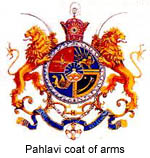|
|
 On 25th April, 1926, the Pahlavi era officially began. Symbolically placing the crown on his head with his own hands, Reza Shah the Great forrnally ended a sad period of national weakness and humiliation and ushered in a new age. The events leading up to this transformation began five vears earlier. On February 22nd, 1921, Reza Khan Mir Panj, as he then was called staged a coup d'état. A military commander of exceptional genius, he had risen from the ranks to command the Cossack Division, the country's, only efficient military force. On 25th April, 1926, the Pahlavi era officially began. Symbolically placing the crown on his head with his own hands, Reza Shah the Great forrnally ended a sad period of national weakness and humiliation and ushered in a new age. The events leading up to this transformation began five vears earlier. On February 22nd, 1921, Reza Khan Mir Panj, as he then was called staged a coup d'état. A military commander of exceptional genius, he had risen from the ranks to command the Cossack Division, the country's, only efficient military force.
Marching his troops from Qazvin, 150 kilometres to the west of Teheran, General Reza Khan seized key parts of the capital almost without opposition and forced the weak and inefficient government of the day to resign. His first post was as army commander, which he later combined with the post of Minister of War, taking at the same time the title Sardar Sepah. Until 1923 there were civilian prime ministers, but the future monarch soon realized that to carry out his task of national salvation he needed wider powers. In 1923 he became Prime Minister, and soon afterwards Ahmad Shah Qajar left for Europe, never to return. On 12th December, 1925, the Majlis, convening as a constituent assembly, voted to vest the crown of Iran "in the person of His Majesty the Shahanshah, Reza Shah Pahlavi... and in his male progeny generation after generation". The following April the formal Coronation took place, and at the same ceremony Mohammad Reza, Reza Shah's eldest son, was proclaimed Crown Prince.
|
| Important events | |
Country name changed from Persia to Iran (1935)2nd world warWhite Revolution |
|
|
Kings:
Rezâ
Mohammad Rezâ
|
Rezâ Shâh
Reza Shah had already undertaken the momentous task of unifying the country, extending the power of the central government and instituting a series of administrative reforms. These tasks completed, he then embarked on the creation of a modern economic infrastructure, building roads and railways, power stations and factories. When Iran became embroiled against its will in the events of World War II, this great monarch's plans were still far from fully implemented, but the foundations of modern Iran, on which today's impressive edifice has been built, had been securely laid till 1979.
In the summer of 1941 the German invasion of the Soviet Union caused the Allies great anxiety, as there was now no safe route to supply the Russians with desperately needed arms. Disregarding Iranian neutrality, Britain and the Soviet Union sent ultimatums to Iran regarding the presence of German nationals in Iran, whom they considered a threat to the security of the vital southern oil industry, and on August 25th invaded Iran from the south, west and north. Shortly afterwards Reza Shah abdicated in favour of his Crown Prince and left the country for exile, first to Mauritius, then to Johannesburg, where he died three years later in bitter sadness.
|
Mohammad Rezâ
It was not easy for the young Shah to reign over a country occupied by foreign troops, with his father, the founder of modern Iran, and the greatest influence on his life, abroad. But those dark days were not entirely wasted and the Shah began to develop his skills as a diplomat and statesman. Although Stalin, Roosevelt and Churchill were preoccupied with post-War European problems when they met a the Teheran Conference in 1943, the Shah succeeded in obtaining guarantees that their troops would be withdrawn from Iran after hostilities ended and full compensation paid for the use of Iran as a supply route. This was never done by the victorious allies.
Iran in fact became known to the Allies as the "Bridge of Victory", across which immense quantities of arms and other supplies were delivered to the Soviet Union, thus facilitating the ultimate Allied victory. Meanwhile, Iran's development plans came to a complete' halt and the country was racked by famine, insecurity, economic stagnation and galloping inflation.
After the War, Stalin reneged on his promise to withdraw Soviet troops. Instead he used them to support secessionist regimes in Azarbaijan and Kurdestan. When Iranian public opinion, backed by international diplomacy and United Nations pressure, forced the Red Army to withdraw, Iranian forces under the command of the Shah marched to these north-west provinces, and in December, 1946, the secessionist movements abruptly collapsed.
|
Dr. Mossadegh
Political instability continued in Tehran, however, and the government of Dr. Mossadegh, a nationalist Iranian to be sure, became embroiled with the still all-powerful Anglo-Iranian Oil Company. Efforts to create a new and vigorous society where blocked. because of continuous quarrels with Britain over the nationalization of our oil industry. This period of tension and instability ended in 1953. Much of Iran still remained firmly in the grip of absentee feudal landlords, determined to keep the rural population in ignorance and economic serfdom, while in the towns industrial workers were often exploited, and corruption in government circles was rampant.
|
White Revolution (Revolution of the Shah and the People)
After a number of disappointments in attempting to implement reforms through parliamentary procedures, which were always blocked by vested interests in the Majlis, the Shah decided to take more positive action. Interpreting his oath of office in its fullest sense, the Shah, after deep consideration, announced the first six points of a revolutionary charter, and on January 26th, 1963, the Nation gave its resounding approval in a referendum in which more than five million persons voted. Thus, in the most democratic way possible, the Revolution of the Shah and the People, as this unprecedented social and economic transformation was called, became an accomplished fact.
|
|

